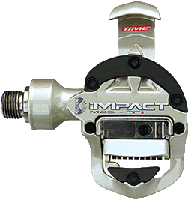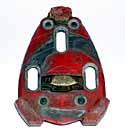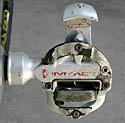
Recently on Cyclingnews.com |
Reviews
Time for an upgrade
Time Impact-Mag-Ti pedals and cleats, November 12, 2003
By Jeff Jones

|
So just how good are the new generation of Time pedals? Cyclingnews Chief Online Editor Jeff Jones road tested a pair of Impact-Mag-Ti's for a period of six months in Belgium, and gave them a really tough workout. Here's the result.
Time Sport has been in the pedal/shoe business for approximately 15 years, and offered one of the first alternatives to the Look clipless pedal in the late '80s. In the beginning, the main difference between the two pedal/shoe systems was the fact that Time pedals allowed your feet to "float" or pivot on the pedals, which was supposed to help reduce pedaling related injuries such as tendonitis. Look's early cleats did not allow this float, and were similar in that respect to toe clips and straps. Things have changed since then, and both systems allow for float, but with Time, the float is incorporated into the pedal and not the cleat, as is the case with Look and Shimano SPD-SL.
Up until late 2002, the Time pedal design had not changed significantly in well over a decade. New models were introduced, but the basic triangular shape with the brass rear cleat and the aluminium/plastic front cleat were pretty constant. The pedal worked well enough, and probably the biggest complaint about it was the weight of the whole system.
Instead of further refining the existing pedal, Time decided to introduce a new and much lighter system, called the Impact, which completely supercedes the old Equipe/Criterium models. With a pair of Impact-Mag-Ti pedals weighing just 240 grams, these have now become one of the lightest pedals on the market. Time has changed the cleat design to reduce its weight and provide more protection while walking, and it has also kept its distinctive float mechanism and large platform size.
There are currently four Impact pedals on the market: Impact-Mag-Ti (top of the range), Impact-Mag, Impact-S and the bog standard Impact. In this review, we tested the Impact-Mag-Ti for a period of five months in sunny Belgium.
Design
The Impact-Mag-Ti pedals are constructed - as their name suggests - largely out of titanium (axle) and magnesium (body), weighing in at a fairly light 240 grams per pair. Combine that with a 110g pair of (mostly plastic) cleats, and the Mag-Ti's are a very lightweight pedal package. Their design is similar in principle to the old Times, but far more compact. The cleat attaches to the pedal via in two places - a small square plastic nodule for the front and a small brass cleat that engages the spring at the rear of the pedal.
A couple of adjustable allen bolts at the side and on the platform of the pedal allow you to change the float tension, angle of release (13° or 17°), and even the lateral position of the foot on the pedal. As with the previous Time pedals, up to 5° of angular float is allowed for, with your foot pivoting over the axle. The cleat itself can be moved forward or backwards on your shoes to suit your preferred pedaling position.
All Impact pedals position the foot quite close to the axle, which is believed to improve efficiency. The distance between the platform and the axle is a mere 7.7 mm, enabling you to experience oneness with your pedal.
Impact cleats are designed to fit all shoes, combining a three-hole Look design with a four-hole Time design, which makes it less of a hassle to fit most shoes. The cleats are supplied with spacers to conform to the curvature of Look soles, but can be removed when used with flat Time soles or Time compatible inserts.
Impressions
Cleat fitting was fairly straightforward, and I installed them on a new pair of Northwave shoes which will be the subject of a future review. It did take some time to get the fore/aft cleat position exactly right, but this is an issue whenever you change shoes and pedals.
Once the cleats were screwed on, I was ready to roll and took the pedals out for a spin along the Schelde river. The very first thing I noticed was how easy it was to clip in and clip out of the Impact-Mag-Ti's, something that I did have occasional problems with the old-style Times. The adjustable pedal tension is certainly handy. The second thing I noticed was the smaller pedal size, even though Time claims the platform is 15 percent bigger than the old pedal/cleat combination. But after one ride and with some very stiff soled shoes, I quickly became used to the new design.
The pedals were given a pretty thorough testing over the next 15,000 km or so, training and racing in various weather conditions. Although they were extremely easy to lock into, not once did I pull out of the pedals in a sprint. This is a good thing. When it was necessary to pull out, then a simple twist of the foot outwards did the trick.
The Impacts felt solid when stomping on the pedals with good power transfer. Admittedly, the new shoes would certainly have contributed to this. Another plus was the improved clearance that the Impacts gave when cornering. Scraping pedals in a bunch tends to set people's hearts racing, and it's very reassuring when you can pedal around 90 degree corners at over 40 km/h...provided you have a clear run of course. Again, I didn't scrape once on a corner with these pedals.
I experimented with adjusting the pedal tension via the allen bolt on the side of each pedal, and it had a noticeable effect. It was possible to effectively reduce the float, which had the corresponding effect that it was harder to clip in and clip out of the pedals. I prefer float, which is why I've always ridden with Times, but it's nice to have the option.
Walking on the cleats (not that I did much of this) was relatively easy with the new semi-recessed cleat design. The triangular plastic supports protect the brass cleat, and give you a more stable platform to clomp around on. The front part of the cleat doubles as one of the supports, but if you walk on your heels as most cyclists do, you will not wear this part of the cleat anyway.
Over time the rear brass cleat did become loose, and being a Bear Of Very Little Brain and one who didn't read the instructions, I could not work out how to tighten it. I opted to replace the cleats after six months, and then realised that it was in fact possible to tighten the brass cleat with a small torque screwdriver, provided the entire cleat is removed from the shoe (the screws point in the opposite direction to the old style Time cleats).
It was about this time that the second realisation hit me that I should have lubricated the screws at least once in the last six months, as they were somewhat...stubborn. Nothing that a hacksaw, a large pair of pliers and a screwdriver couldn't fix. I should point out that the screws rusting into holes is not really a design problem with the Times and/or Northwaves, it's merely my own neglect compounded by occasional appalling weather.
On the other hand, perhaps the cleats needed replacing anyway. I am sure I will get more than 15,000 km out of the next set.
Conclusions
While pedal preferences are very much a personal thing, one thing that can be said about the Time Impact-Mag-Ti pedals is that they are an improvement on the old models, which have done commendable service for the last 15 years. The reduced weight, improved pedal clearance, adjustable float, the ease of clipping in/out and walking on make these a very "user friendly" set of clipless pedals. The rate of cleat wear was harder to determine from this test, although the brass cleats were certainly showing signs of wear when I chose to replace them.
Photography
Images by Time Sport
- The Time Impact-Mag-Ti pedal is Time's lightweight top of the range model
Images by Jeff Jones/Cyclingnews
- The Impact cleats come with a spacer (L) to fit to the curvature of Look shoes
- A nice shiny new Time Impact cleat. Note the two stabilisers on the back that enable easier walking.
- The rear view of the new Time cleat. Only 55g.
- The Impact cleat attached to the shoe
- After six months and 15,000 km of solid wear, the Impact cleat was still serviceable
- After six months and 15,000 km the pedal was showing signs of wear, but its function was not affected
Recommended retail price: US$280 (pedals), US$37 (cleats)
Weight (per pair): Pedals: 240g, Cleats: 110g
Pro: Light, easy to clip in/clip out, better clearance, adjustability
Con: Expensive for their weight
More information: Time's
website
Cyclingnews Rating: ![]()
What do you think of the Time Impact pedals? Let us know







